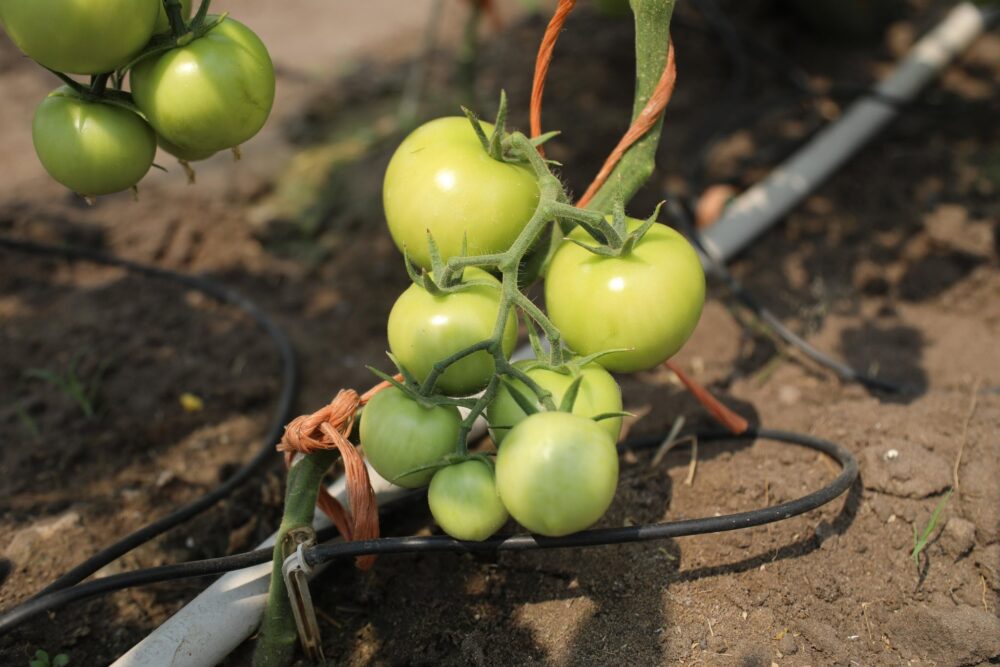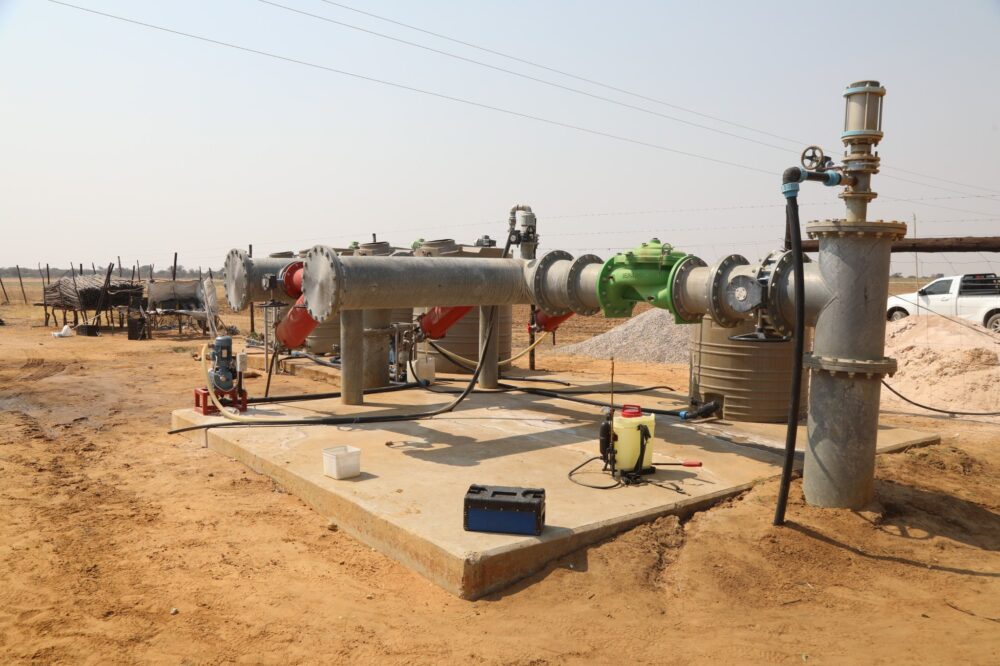Namibia has schemes and together, they represent one of the most ambitious agricultural investments in southern Africa — spanning thousands of hectares of irrigated land, with access to perennial rivers and soils suited to maize, wheat and horticulture. Photos: Namibia Presidency
For nearly two decades, Namibia has held up its green schemes as the backbone of its food security ambitions: state-backed irrigation farms meant to reduce import dependence, unlock rural employment, and drive agro-industrial growth along the Kavango and Zambezi rivers.
The country now has 11 such schemes and together, they represent one of the most ambitious agricultural investments in southern Africa — spanning thousands of hectares of irrigated land, with access to perennial rivers and soils suited to maize, wheat and horticulture.
But a new parliamentary inquiry reveals a stark truth: the system is on the brink of collapse.
In August, the parliamentary standing committee on natural resources conducted an oversight visit to the green schemes in Zambezi, Kavango East and Kavango West. Its report concludes that while the schemes remain essential for food security and rural livelihoods, “persistent challenges, if left unaddressed, may kill the Green Scheme entirely”.
What emerges is a picture of institutional paralysis, chronic underinvestment, bureaucratic gridlock and operational failures so severe that some farms have stopped producing altogether.
A flagship rice project on the edge of collapse
The Kalimbeza rice project, launched in the 2000s with strong political backing and the vision of a national rice industry, presents perhaps the starkest example of dysfunction.
The committee found that of its 229 hectares, only 150 remain suitable for rice due to long-neglected soil management. Broken machinery litters the fields, fences have been cut repeatedly by nearby communities, allowing cattle to trample crops, and water distribution systems do not function consistently.
Production has all but collapsed.
A 2024 harvest of 180 tonnes of raw rice has been sitting in storage, unprocessed, for months because the processing machine has been broken for the same period. Despite funds allocated for a replacement, procurement delays in Windhoek mean no new equipment has arrived.
To make matters worse, Kalimbeza’s only storage facility is neither climate-controlled, pest-proof, nor protected from dust. The committee warns that retailers may reject future rice shipments due to contamination.
Even the project’s finances reveal deeper structural problems. Of the N$18 million (R18 million) budgeted for Kalimbeza in 2024/25, N$8 million (R8 million) was assigned to a consultant. Committee members questioned the economic logic and flagged this as a sign of system-wide misalignment.
The inquiry’s judgment was blunt. Kalimbeza, initiated under Namibia’s late founding president Sam Nujoma, is now in a “disastrous state”. Production persists, but on ageing machinery.
The Shadikongoro Green Scheme in Kavango East offered only a marginally more positive picture, as it continues to produce maize, wheat and small quantities of sunflower.
In the 2023/24 summer season, it yielded 1 393 tonnes of maize and 20 tonnes of sunflower and also supports surrounding villages with water deliveries, tractor services and occasional food donations to vulnerable households.
But production relies on outdated equipment.
The scheme owns only two tractors. It has no combine harvester and must borrow from neighbouring farms. A wheat milling plant installed in 2015 has never been used. Smaller machinery handles milling and oil pressing, but outputs are inconsistent.
Workers, too, are feeling the strain. Most wages have remained stagnant since 2017, and several contract workers have remained “temporary” for more than five years.
The committee links this to the unresolved dissolution of AgriBusDev — the parastatal formerly responsible for the schemes — which was formally shut down in 2021 but still not fully integrated into ministry structures four years later.

A rare example of what works
Against this backdrop of decay, Ndonga Linena stands out for its relative success. Under manager Janno Rentel, the scheme has adopted precision farming technologies — soil sensors, automated irrigation, digital crop monitoring and real-time yield tracking. This has dramatically improved efficiency, reduced waste and boosted yields.
In 2025, the scheme harvested 1 900 tonnes of maize from its commercial blocks, valued at N$17.94 million. Small-scale farmers produced 627 tonnes, which were delivered to the Agro-marketing Trade Agency. Winter wheat — grown on 110 hectares — produced 660 tonnes valued at N$5.61 million.
For 2025/26, the scheme aims to plant 420 hectares each of maize and wheat, with projected revenue exceeding N$47 million. But even this model project is weighed down by systemic failures. Small-scale farmers face electricity bills exceeding N$1 million a month.
Fertiliser and chemical costs continue to rise. Communication with the ministry is weak, and there are no pathways for graduating from small-scale to medium-scale status.
Their grievances include mismanagement of inputs, planting delays caused by poor coordination and exclusion from decision-making processes that directly affect their operations.

Investment undermined by unpaid revenue
At Uvhungu-Vhungu, a government-supported green scheme project in Kavango East, the committee found evidence of both investment and severe financial vulnerability.
Since 2022, the scheme has refurbished pump stations, acquired a 132 kW tractor, installed a new wheat planter and bought a combine harvester. Production volumes have been respectable: 1 191 tonnes of maize from the 2024/25 commercial season.
Yet the farm cannot escape financial instability.
The Namibia Revenue Agency reportedly owes the project N$2.5 million in outstanding VAT refunds, which have been outstanding for four years. For a farm that battles to maintain equipment, the impact is profound. Small-scale farmers have not been paid for produce delivered eight months ago.
To compound matters, Uvhungu-Vhungu has no single storage facility. Maize must be harvested and loaded the moment trucks arrive — an expensive, inefficient process caused by chronic underinvestment.
The Sikondo Green Scheme in Kavango West continues to produce potatoes, wheat, cabbage and onions, supplying affordable food to local markets. It has grown the Mondial potato variety for 13 years and is diversifying into fruit orchards and a cattle feedlot. But electricity costs are unmanageable, machinery is outdated, and soil fertility is declining.
Musese, operated privately, performs better: it produces maize meal locally and employs local workers. But frequent power outages disrupt operations.
Despite the scale of the green scheme programme, Namibia remains heavily dependent on neighbouring South Africa for food.
According to the United Nations Food and Agriculture Organisation, the country imports about two-thirds of all cereals it consumes, while South Africa continues to dominate Namibia’s food supply chain.
In 2024 alone, Namibia imported US$57.98 million worth of vegetable, fruit, and nut food preparations from South Africa. South Africa also supplied over 35% of Namibia’s total imports in May 2024.
This structural dependency persists even as eleven state-backed irrigation farms sit underutilised or stalled. The parliamentary committee notes that until the schemes operate at full capacity, South Africa will continue to set both the availability and the price of staple foods in Namibia.

A systemic failure
Perhaps the report’s most powerful finding is that the system — not the farmers — is failing.
AgriBusDev was dissolved in 2021 after years of mismanagement, debt and operational decay. Its collapse forced the ministry of agriculture to take over.
But integration has been slow and directionless. Instead of decentralising operations to the regions, the ministry centralised decision-making in Windhoek, creating a bottleneck that now threatens the entire programme.
Routine repairs — such as tractor tyre replacements or pump servicing — take weeks because approval must pass through the capital.
Procurement is unpredictable. Machinery remains idle while paperwork circulates. The committee concludes that this bureaucratic blockage is “undermining productivity and may kill the green scheme entirely”.
Regional governors offered damning assessments.
Zambezi governor Dorothy Kabula said land and infrastructure are being “left idle” while unemployment rises. Kavango East governor Hamunyera Hambyuka warned that the region has the land, water and capacity to produce maize and wheat at scale — but poor management and centralised oversight limit actual output.
Kavango West governor Verna Sinimbo highlighted that unemployment exceeds 50% and called the committee’s visit “critical” to addressing long-standing governance failures.
The committee calls for a complete turnaround strategy: root-cause analysis, financial restructuring, improved management, decentralised procurement, investment in modern machinery, support for small-scale farmers and an inter-ministerial system to supply produce to schools, hospitals and correctional facilities.
The potential remains enormous. Ndonga Linena shows what is possible when technology, management and state support align. Even collapsing schemes like Kalimbeza still have soil, water and land that can produce — if the system governing them is fixed.
Namibia’s green schemes could feed the nation. The question is whether political will can finally match agricultural potential.